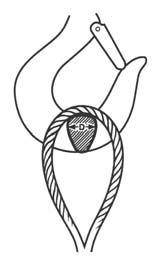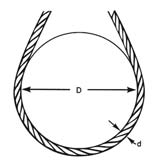
|
|
|




SLINGS
WIRE ROPE
GENERAL INFORMATION
TABLE 1
CHOKER HITCH RATED
CAPACITY ADJUSTMENT
ANGLE OF CHOKER IN
RATED CAPACITY IWRC
DEGREES**
AND FC ROPE PERCENT
OVER 120
100
90 120
87
60 89
74
30 59
62
Figure 1.
0 29
49
NOMINAL SLING STRENGTH is based upon the nominal
**Percent of sling rated capacity in a choker hitch.
(catalog) rope strength of the wire rope used in the sling
CHOKER HITCH configurations affect the rated capacity
and other factors which affect the overall strength of the
of a sling. This is because the sling leg or body is passed
sling. These other factors include splicing efficiency, num
around the load, through one end attachment or eye. The
ber of parts of rope in the sling, type of hitch (e.g. straight
contact of the sling body with the end attachment or eye
pull, choker hitch, basket hitch, etc.), diameter around
causes a loss of sling strength at this point. If a load is
which the body of the sling is bent (D/d) and the diameter
hanging free, the normal choke angle is approximately 135
of pin used in the eye of the sling (Figure 1).
degrees. When the angle is less than 135 degrees an
adjustment in the sling rated capacity must be made
(Figure 3). As can be seen, the decrease in rated capacity
is dramatic. Choker hitches at angels greater than 135
degrees are not recommended since they are unstable.
Extreme care should be taken to determine the angle of
choke as accurately as possible.
NOMINAL SPLICE EFFICIENCY is the efficiency of the
sling splice. Any time wire rope is disturbed such as in
splicing an eye, the strength of the rope is reduced. This
reduction must be taken into account when determining
the nominal sling strength and in calculating the rated the
Figure 2.
capacity. Each type of splice has a different efficiency,
SLING ANGLE is the angle measured between a horizon
thus the difference in rated capacities for different types if
tal line and the sling leg of the body. This angle is very
slings. Nominal splice efficiencies have been established
important and can have a dramatic effect on the rated
after many hundreds of tests over years of testing.
capacity of the sling. As illustrated above, when this prin
ciple applies whether one sling is used to pull at an angle,
in a basket hitch or for multi legged bridle slings. Sling
angles of less than 30 degrees are not recommended.
Figure 4.
D/d ratio is the ratio of the diameter around which the sling
is bent divided by the body diameter of the sling (Figure
4). This ratio has an effect on the rated capacity of the
Figure 3.
sling only when the sling is used in a basket hitch. Tests
have shown that whenever wire rope is bent around a
diameter the strength of the rope is decreased. Figure 5
illustrates the percentage of decrease to be expected.
38